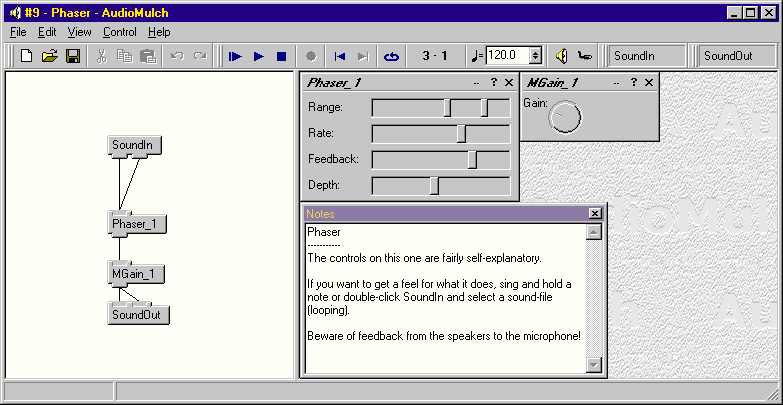
FLUID SOUND CONTROL
 |
TECHNOLOGY:
FLUID SOUND CONTROL |
|
By default, the SoundBeam enables you to play notes on a (customisable) scale as you make movements with the sensors. It does this by producing a stream of MIDI messages that play an attached synthesizer. The aim in CARESS was to take this one stage further, by replacing individual notes with a more fluid audio stream, in which the pitch would smoothly glide up and down. This fluidity of control does not have to be for just pitch, either. Other properties of sound can also be controlled, depending on the capabilities of the synthesizer.
Originally, this part of the project was to be done in two parts, one to alter the behaviour of the synthesizer (by generating an alternative MIDI stream based on what was produced by the SoundBeam) and one to bring inuitive control of timbre (by mapping all the instruments of a synthesizer onto a virtual space that can be navigated with sensors). Instead, these aims were combined... and surpassed... by using a soft-synth running on a computer.
The soft-synth can be graphically configured to produce whatever behaviour is wanted and it responds to MIDI (via the joystick/MIDI connection on the soundcard). Not only can it be used to synthesize sounds under control of the sensors; it can also be used with a live sound source (from a microphone) where the sensors change the sound. This greatly enhances the scope of what can be done with Sound Therapy, especially in mainstream schools, where the children can also get involved in 'designing' new sound environments.
You can download all the setups free from this page (and get the shareware soft-synth via the internet).
Echo with optional feedback, an in-built contraption of AudioMulch. The delay times can be different for the left and right speakers.
Note that the computer has an inherent delay, called a latency. It is primarily due to the soundcard and can vary from 10ms (as good as instantaneous) to several hundred milliseconds (sluggish). This, and the machine's power, decide how large the buffers (and hence the total latency) need to be for smooth operation (press F4).
'Feedback' and 'Wet/Dry mix' parameters: these control the strength of the echo and the number of repetitions. With maximum feedback, the echoes will continue indefinitely.
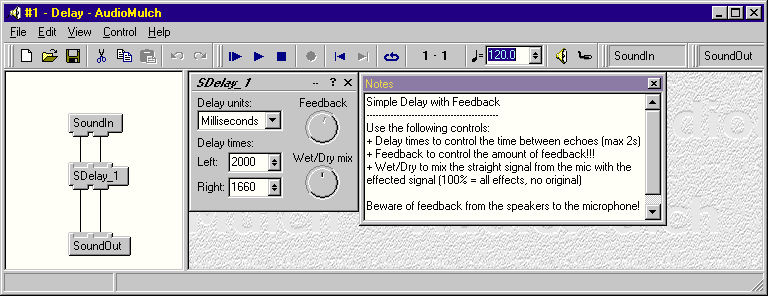
A longer version of #1 above. Each delay contraption in AudioMulch can be a maximum of 2 seconds, so four of these were chained to provide an overall 8 seconds maximum delay.
all the 'Delay times' parameters configured to a single MIDI controller, so that the delay can be set over the entire 0 to 8 second range with a single action (using a MIDI keyboard). Note that when this changes, AudioMulch does not make a smooth job of it, so you can get some choppiness. We suggest this be assigned to a MIDI keyboard controller for 'off-line' control.
'Feedback' parameters configured to a single MIDI controller, enabling control of the number and volume of later echoes after the initial delay from a single sensor. Therefore, after the initial echo, which may take up to 8 seconds, there will be subsequent echoes that can be made to last indefinitely. Because each delay unit will generate later echoes, these will come more rapidly and ultimately become somewhat diffuse, like natural reverberation.
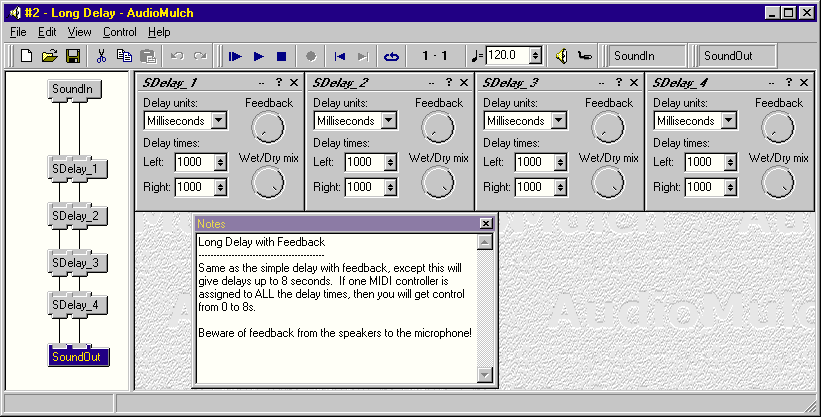
This setup incorporates a delay with feedback followed by a reverb. The delay loop enables echoes which decrease or increase in volume over time, controlled by the Gain knob. Beware, this one can get loud if you are not careful. Reverb is controlled with two parameters: Reverb time, which affects how muddied the sound becomes, and Wet/dry mix, which affects the relationship between the source sound and the reverberated sound. Together they affect the brightness and size of the simulated room. Therefore, a wide range of room types can be simulated, from a small carpeted room to a large stone cavern, but using sliding controls on a continuous scale, rather than discrete descriptions.
controlling the amount of reverb: 'Wet/dry mix' and the impression of the room size: 'Reverb time' from sensors. The Gain control affects whether the echoes increase or decrease in volume and this is expected to be controlled by the teacher, since large values will produce the 'overload' situation, which could become painfully loud if unchecked.
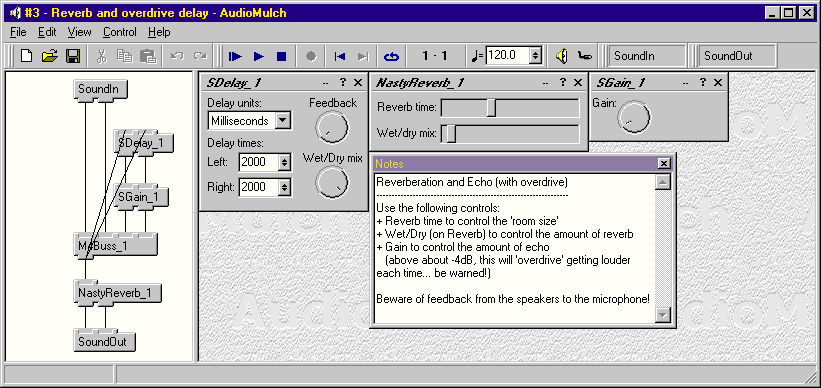
A softer, safer version of #3, this includes the same reverb, but it is followed by exactly three echoes. Each echo gets louder than the last, but because there is no feedback loop, it is impossible for this to get out of control.
controlling the amount of reverb: 'Wet/dry mix' and the impression of the room size: 'Reverb time' from sensors, as in #3.
all the 'Delay times' parameters configured to a single MIDI controller, so that the delay times of the later echoes can be altered simultaneously and identically (off-line) from a MIDI keyboard controller. (See note in #2 about delay times.)
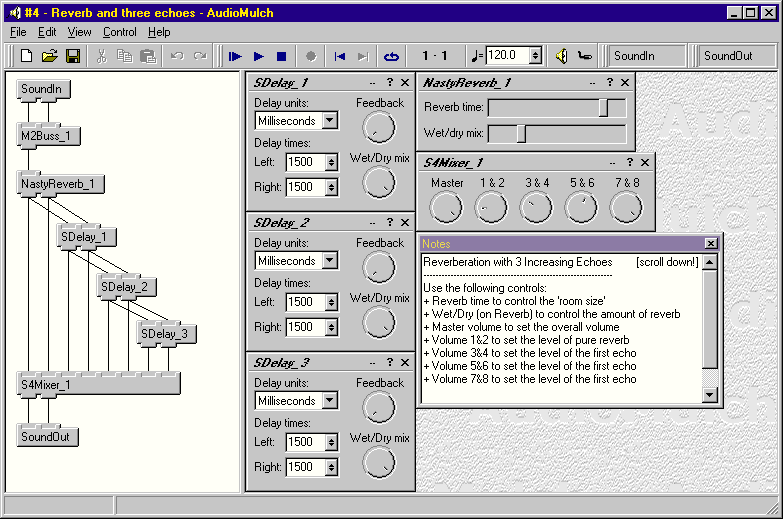
The sound source passes through an initial delay and then into the 4x4 Matrix. This matrix routes the sound to any or all of the four delay units (including the one it came from). Each of the delay units has its own delay time (which is also different for left and right channels). Similarly the sounds exiting those delays go through the matrix, which again re-routes them. (The routing is different for input from each delay unit.) Because each of the delay times has been randomly selected, the sound at first has distinct echoes, but they gradually become more diffused (rather like a real room environment). The black/white squares in the 4x4 matrix decide the sound routing and hence, the characteristics of the echoes. Try changing this in real-time with the mouse.
the 'Wet/Dry mix' of each of the delay units (separately). This will allow the effect of each delay unit to be be progressively added or removed. The sound will range from very clear (a single delay) to totally muddled.
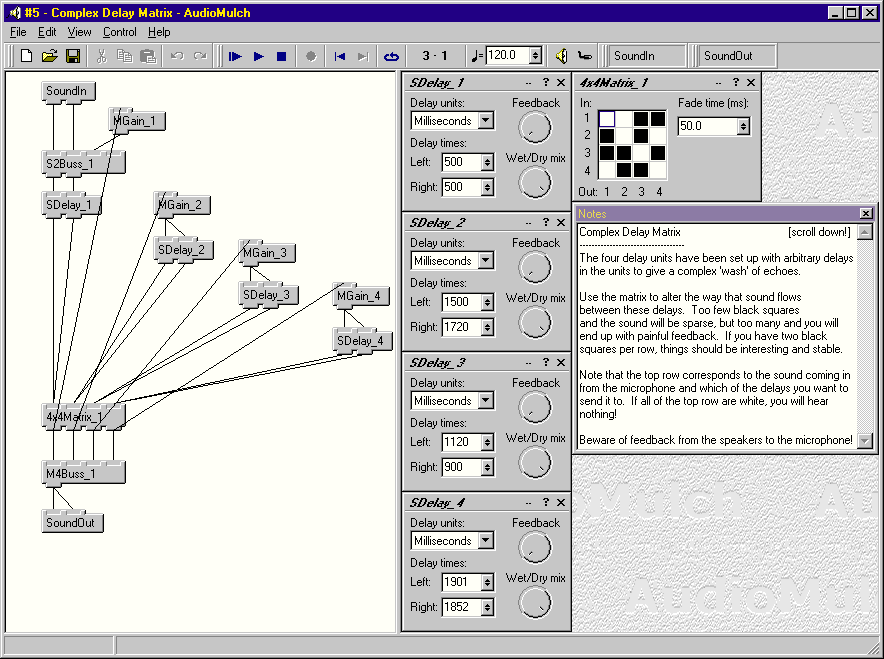
The setup is actually the same as #5, but the delay time values are specific ratios, instead of random numbers. The effect is of generating rhythmic echoes. Experience shows that this encourages percussive sounds to be vocalised at the microphone, to hear what rhythm is created.
'Wet/Dry mix' of each of the delay units, so that their effect can be progressively added or removed, as with #5. The rhythm produced is therefore selected from the sensors, by how they are moved, and their actions affect one another, so co-operation can be explored.
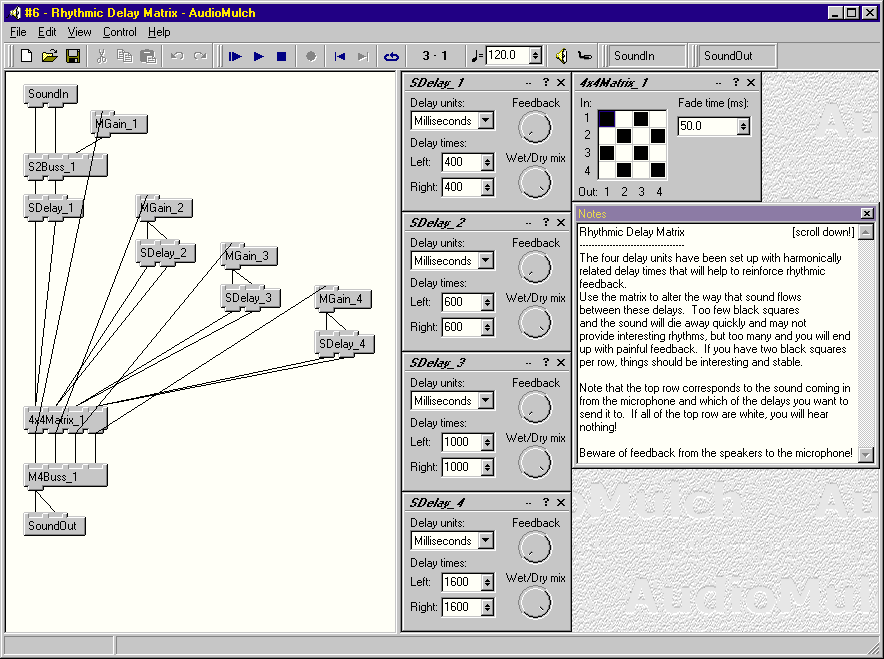
The Granulator contraption is a granular synthesizer and it is configured to enable real-time pitch shifting. Sound from this is fed back in a loop via a delay unit. If a transpose of +100 cents is set, then the sound will climb up the chromatic scale (one semitone at a time) at the rate set by the delay unit. If the delay is very small, the sound appears to swirl upwards or downwards (depending on the sign of the transpose). If a note is sung and sustained as the sound input, a chord will be produced. With the transpose set to values such as 300, 400, 500 or 700 (=3,4,5 or 7 semitones), the sound will ascend in the musical intervals of minor 3rd, major 3rd, fourth or fifth (half-octave) producing consonant or dissonant chords and harmonies.
'Transpose' to achieve large or small (microtonal) pitch shifts, 'Volume 3&4' to affect the presence of the feedback, and 'Wet/Dry mix' to control the degree to which the sound moves in steps or as a swirling chord. 'Grain Duration' can also be controlled but the range may need to be restricted; this will change the sound from being smooth to gritty.
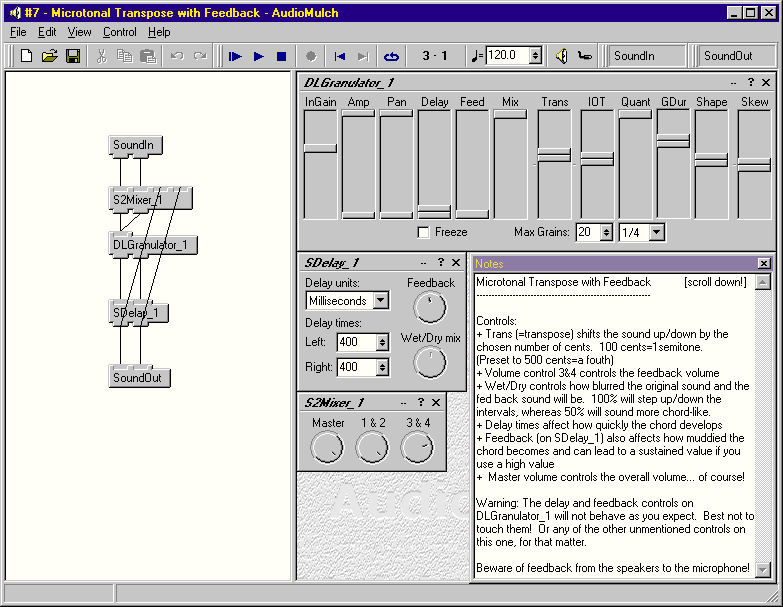
The Flanger is a standard effect and is implemented as a single contraption in AudioMulch. Therefore this setup is very simply the Flanger contraption and a master volume control for the Sound Therapy teacher. Its effects are best noticed on very short percussives or prolonged notes.
controlling the frequency 'Range' of the flange, the 'Rate' of variation - these equates to the depth and speed of sweep respectively - and the 'Wet/dry mix' which affects the strength of presence of the effect.
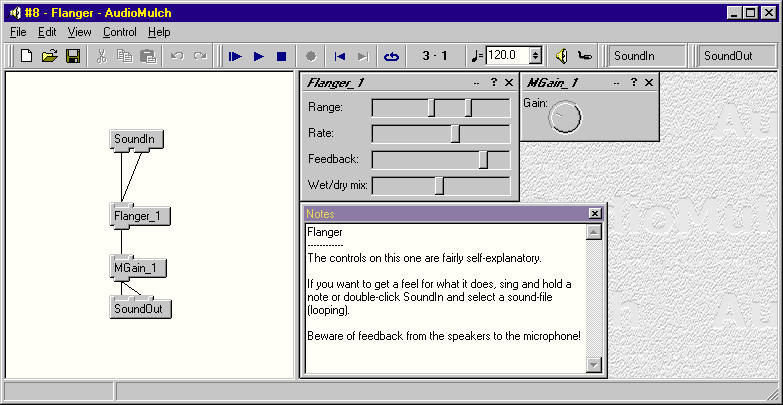
Like the Flanger, the Phaser is a standard effect and is implemented as a single contraption in AudioMulch. Therefore this setup is very simply the Phaser contraption and a master volume control for the Sound Therapy teacher.
controlling the frequency 'Range', the 'Rate' of variation and the 'Wet/dry mix', as for #8.
